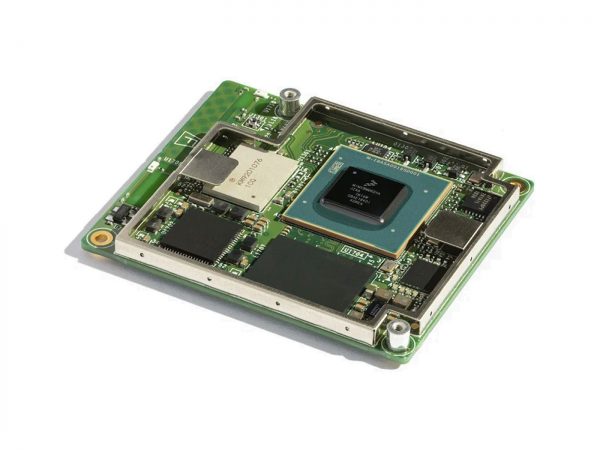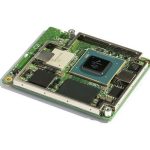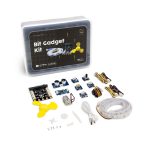PRODUCT DETAILS
Attention
This product has shipping restriction to certain countries. It can only be sent to countries and regions listed as below: United States, Japan, Korea, Hong Kong, Taiwan, Australia, New Zealand, India, Ghana, Singapore , Oman, Philippines, Thailand, Austria, Belgium, Bulgaria, Croatia, Cyprus, Denmark, Estonia, Fiji, Germany, Greece, Hungary, Ireland, Italy, Latvia, Lithuania, Luxembourg, Malta, Netherlands, Poland, Portugal, Romania, Slovakia, Slovenia, Spain, Sweden, United Kingdom, Switzerland, Iceland, Liechtenstein, Norway, Turkey
Note
Seeed fusion offers PCB/ PCBA manufacturing service for customized products based on Coral System-on-Module (SoM) – 1GB RAM Version with an online instant quote and fast delivery. Furthermore, business users can enjoy a free prototype and engineer support as well. Click here to learn more!
Key Features
- Provides a complete system: The Coral SoM is a fully-integrated Linux system that includes NXP’s iMX8M system-on-chip (SoC), eMMC memory, LPDDR4 RAM, Wi-Fi, and Bluetooth, and the Edge TPU coprocessor for ML acceleration. It runs a derivative of Debian Linux we call Mendel.
- Performs high-speed ML inferencing: The on-board Edge TPU coprocessor is capable of performing 4 trillion operations (tera-operations) per second (TOPS), using 0.5 watts for each TOPS (2 TOPS per watt). For example, it can execute state-of-the-art mobile vision models such as MobileNet v2 at 400 FPS, in a power efficient manner.
- Integrates with your custom hardware: The SoM connects to your own baseboard hardware with three 100-pin connectors.
- Supports TensorFlow Lite: No need to build models from the ground up. TensorFlow Lite models can be compiled to run on the Edge TPU.
- Supports AutoML Vision Edge: Easily build and deploy fast, high-accuracy custom image classification models to your device with AutoML Vision Edge. Also available with a baseboard as part of the Coral Dev Board.
Description
The Coral System-on-Module (SoM) is a fully-integrated system that helps you build embedded systems that demand fast machine learning (ML) inferencing. It contains NXP’s iMX8M system-on-chip (SoC), eMMC memory, LPDDR4 RAM, Wi-Fi, and Bluetooth, but its unique power comes from Google’s Edge TPU coprocessor.
The Edge TPU is a small ASIC designed by Google that provides high-performance ML inferencing with a low power cost. For example, it can execute state-of-the-art mobile vision models such as MobileNet v2 at almost 400 FPS, in a power-efficient manner. This on-device processing reduces latency, increases data privacy, and removes the need for a high-bandwidth connection used to perform ML inferencing in the cloud.
Key benefits of the SoM:
- High-speed and low-power ML inferencing (4 TOPS @2 W)
- A complete Linux system (running Mendel, a Debian derivative)
- Small footprint (40 x 48 mm)
The SoM is also included in the Coral Dev Board, which is a single-board computer that enables fast prototyping and evaluation of the standalone SoM.
Specification
- NXP i.MX 8M SoC
- Quad-core ARM Cortex-A53, plus Cortex-M4F
- 2D/3D Vivante GC7000 Lite GPU and VPU
- Google Edge TPU ML accelerator
- Cryptographic coprocessor
- Wi-Fi 2×2 MIMO (802.11b/g/n/ac 2.4/5 GHz)
- Bluetooth 4.2
- 8GB eMMC
- 1GB LPDDR4
- USB 3.0
- Gigabit Ethernet
- HDMI and MIPI-DSI
- MIPI-CSI-2
- Up to 95x GPIO (including SPI, I2C, PWM, UART, SAI, and SDIO)
| Feature | Details |
|---|---|
| Main system-on-chip (i.MX8M) | |
| Arm Cortex-A53 MPCore platform | Quad symmetric Cortex-A53 processors:
Support of 64-bit Armv8-A architecture:
|
| Arm Cortex-M4 core platform |
|
| Graphic Processing Unit (GPU) |
|
| Video Processing Unit (VPU) |
|
| I/O connectivity |
Note: The list above is the number of signals available to the baseboard (after considering SoC signals used by the SoM). |
| On-chip memory |
|
| External memory |
|
| Display | HDMI Display Interface:
MIPI-DSI Display Interface:
|
| Audio |
|
| Camera |
|
| Security |
|
| ML accelerator | |
| Edge TPU coprocessor |
|
| Memory and storage | |
| Random access memory (SDRAM) |
|
| Flash memory (eMMC) |
|
| Expandable flash (MicroSD) |
|
| Network & wireless | |
| Ethernet |
|
| Wi-Fi | Murata LBEE5U91CQ module:
|
| Bluetooth | Murata LBEE5U91CQ module:
|
| Security | |
| Cryptographic coprocessor | Microchip ATECC608A cryptographic coprocessor:
|
| Hardware interface | |
| Baseboard connectors | 3x 100-pin connectors (Hirose DF40C-100DP-0.4V) |
| Antenna connectors | 2x coaxial cable connectors (Murata MM8930-2600) |
Block Diagrams
Block diagram of the SoM components
Block diagram of the i.MX8M SoC components, provided by NXP
Dimensions
Part List
1x Coral System-on-Module(SOM)
ECCN/HTS
| HSCODE | 8543709990 |
| USHSCODE | 8473301140 |
| UPC |
Coral System-on-Module (SoM) – 1GB RAM Version
$99.99
The Coral System-on-Module (SoM) is a fully-integrated system that helps you build embedded systems that demand fast machine learning (ML) inferencing.
Coral System-on-Module (SoM) – 1GB RAM Version
$99.99
The Coral System-on-Module (SoM) is a fully-integrated system that helps you build embedded systems that demand fast machine learning (ML) inferencing.
PRODUCT DETAILS
Attention
This product has shipping restriction to certain countries. It can only be sent to countries and regions listed as below: United States, Japan, Korea, Hong Kong, Taiwan, Australia, New Zealand, India, Ghana, Singapore , Oman, Philippines, Thailand, Austria, Belgium, Bulgaria, Croatia, Cyprus, Denmark, Estonia, Fiji, Germany, Greece, Hungary, Ireland, Italy, Latvia, Lithuania, Luxembourg, Malta, Netherlands, Poland, Portugal, Romania, Slovakia, Slovenia, Spain, Sweden, United Kingdom, Switzerland, Iceland, Liechtenstein, Norway, Turkey
Note
Seeed fusion offers PCB/ PCBA manufacturing service for customized products based on Coral System-on-Module (SoM) – 1GB RAM Version with an online instant quote and fast delivery. Furthermore, business users can enjoy a free prototype and engineer support as well. Click here to learn more!
Key Features
- Provides a complete system: The Coral SoM is a fully-integrated Linux system that includes NXP’s iMX8M system-on-chip (SoC), eMMC memory, LPDDR4 RAM, Wi-Fi, and Bluetooth, and the Edge TPU coprocessor for ML acceleration. It runs a derivative of Debian Linux we call Mendel.
- Performs high-speed ML inferencing: The on-board Edge TPU coprocessor is capable of performing 4 trillion operations (tera-operations) per second (TOPS), using 0.5 watts for each TOPS (2 TOPS per watt). For example, it can execute state-of-the-art mobile vision models such as MobileNet v2 at 400 FPS, in a power efficient manner.
- Integrates with your custom hardware: The SoM connects to your own baseboard hardware with three 100-pin connectors.
- Supports TensorFlow Lite: No need to build models from the ground up. TensorFlow Lite models can be compiled to run on the Edge TPU.
- Supports AutoML Vision Edge: Easily build and deploy fast, high-accuracy custom image classification models to your device with AutoML Vision Edge. Also available with a baseboard as part of the Coral Dev Board.
Description
The Coral System-on-Module (SoM) is a fully-integrated system that helps you build embedded systems that demand fast machine learning (ML) inferencing. It contains NXP’s iMX8M system-on-chip (SoC), eMMC memory, LPDDR4 RAM, Wi-Fi, and Bluetooth, but its unique power comes from Google’s Edge TPU coprocessor.
The Edge TPU is a small ASIC designed by Google that provides high-performance ML inferencing with a low power cost. For example, it can execute state-of-the-art mobile vision models such as MobileNet v2 at almost 400 FPS, in a power-efficient manner. This on-device processing reduces latency, increases data privacy, and removes the need for a high-bandwidth connection used to perform ML inferencing in the cloud.
Key benefits of the SoM:
- High-speed and low-power ML inferencing (4 TOPS @2 W)
- A complete Linux system (running Mendel, a Debian derivative)
- Small footprint (40 x 48 mm)
The SoM is also included in the Coral Dev Board, which is a single-board computer that enables fast prototyping and evaluation of the standalone SoM.
Specification
- NXP i.MX 8M SoC
- Quad-core ARM Cortex-A53, plus Cortex-M4F
- 2D/3D Vivante GC7000 Lite GPU and VPU
- Google Edge TPU ML accelerator
- Cryptographic coprocessor
- Wi-Fi 2×2 MIMO (802.11b/g/n/ac 2.4/5 GHz)
- Bluetooth 4.2
- 8GB eMMC
- 1GB LPDDR4
- USB 3.0
- Gigabit Ethernet
- HDMI and MIPI-DSI
- MIPI-CSI-2
- Up to 95x GPIO (including SPI, I2C, PWM, UART, SAI, and SDIO)
| Feature | Details |
|---|---|
| Main system-on-chip (i.MX8M) | |
| Arm Cortex-A53 MPCore platform | Quad symmetric Cortex-A53 processors:
Support of 64-bit Armv8-A architecture:
|
| Arm Cortex-M4 core platform |
|
| Graphic Processing Unit (GPU) |
|
| Video Processing Unit (VPU) |
|
| I/O connectivity |
Note: The list above is the number of signals available to the baseboard (after considering SoC signals used by the SoM). |
| On-chip memory |
|
| External memory |
|
| Display | HDMI Display Interface:
MIPI-DSI Display Interface:
|
| Audio |
|
| Camera |
|
| Security |
|
| ML accelerator | |
| Edge TPU coprocessor |
|
| Memory and storage | |
| Random access memory (SDRAM) |
|
| Flash memory (eMMC) |
|
| Expandable flash (MicroSD) |
|
| Network & wireless | |
| Ethernet |
|
| Wi-Fi | Murata LBEE5U91CQ module:
|
| Bluetooth | Murata LBEE5U91CQ module:
|
| Security | |
| Cryptographic coprocessor | Microchip ATECC608A cryptographic coprocessor:
|
| Hardware interface | |
| Baseboard connectors | 3x 100-pin connectors (Hirose DF40C-100DP-0.4V) |
| Antenna connectors | 2x coaxial cable connectors (Murata MM8930-2600) |
Block Diagrams
Block diagram of the SoM components
Block diagram of the i.MX8M SoC components, provided by NXP
Dimensions
Part List
1x Coral System-on-Module(SOM)
ECCN/HTS
| HSCODE | 8543709990 |
| USHSCODE | 8473301140 |
| UPC |






